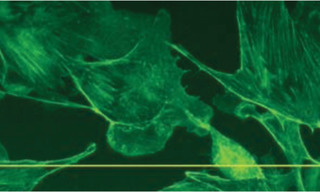Look at the two images of fluorescent actin below. At first glance, they appear almost identical, but closer inspection reveals a significant difference. The first image was obtained using a SPECTRA X Light Engine with a 475/40 (CWL/FWHM) cyan excitation filter. For the second image, a 475/28 cyan excitation filter was used, instead. All other image acquisition conditions were identical. The detected fluorescence levels in the first image are higher than in the second image, due to the increased excitation bandwidth. However, the background levels are also higher due to a small amount of excitation light bleed-through. Bleed-through is due to the bandwidth of the excitation filter being too wide, allowing a fraction of the excitation light to pass through the emission filter to the camera. The first image shows the typical manifestation of a bleed-through — a uniform intensity increase in all pixels that is most clearly seen in the non-fluorescent background signal levels. A plot of the pixel intensity values across the image shows the effect more clearly. Although the second image is not as bright as the first, it has superior signal:background characteristics, ultimately resulting in lower detection thresholds for weakly fluorescent structures.

Center wavelength/full width half maximum bandpass, in nm.



